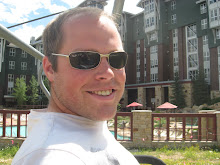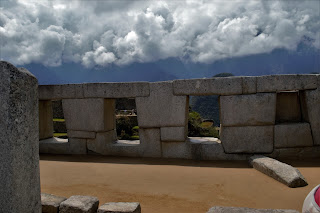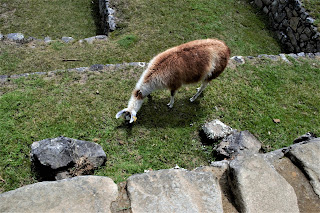We stayed for two nights at a hotel in Aguas Calientes, or the Machu Picchu Pueblo, which is a 25-minute bus ride away from the ruins. It was a small town that we ended up seeing every square inch of. There were dogs everywhere. The dogs are kind of like cats in Peru - they roam around the streets during the day while their owners are at work and come back home at dinnertime. But at the Machu Picchu Pueblo specifically, I guess the dogs are community dogs. All the people and business owners take care of the dogs and feed them, and even take turns bathing them when they get too dirty. Because of this, the dogs were super friendly - there was no such thing as stranger danger with these dogs. Pictured above is a dog that followed us along the street for a little bit that we named Bernard. He was a good boy.
On our third day at Machu Picchu, we got kicked out of our hotel at 10:00 am and our train taking us to Cusco didn't leave until 6:20 pm, so we had all day with nothing scheduled. We thought about buying another bus ticket up to the ruins and exploring Machu Picchu for a third day, but between the bus ticket and entrance fee, it would have been kind of expensive, and our legs were wrecked from the previous day's hike. This picture above and below is right outside our hotel early in the morning as we were deciding what to do for the next 8 hours.
It was such a beautiful town. I couldn't help but wonder if the people who live there appreciate the beauty they are surrounded by.
Everywhere we looked we saw Peruvians getting ready for the upcoming rainy season by piling sandbags all along the river. I'm so grateful that is not something I have to consistently worry about!
These three dogs came and joined us while we were enjoying the view of the river. Chris named them Bear, Sally, and Gail. The one in front is Bear, and the one hidden underneath me is Gail. Gail kept barking at people passing by us, almost like he was protecting us. As fun as I thought all the dogs roaming around were, we didn't ever touch them.
A dog sleeping in a food cart. After this, Chris said we were done taking pictures of dogs. We came by later and saw a kitty cat snuggling with him.
A pretty river flowing by a restaurant we ate at.
So there were two bridges that had locks on them. I wanted to add a lock to the bridge, and we had 8 hours to kill, so we set about looking for a shop that would sell us a lock. You'd be amazed how difficult it is to get someone to understand that you'd like to purchase a lock when they don't speak English. Chris had a translator app that we used the whole time in Peru, and even with that, people didn't understand. It was actually a Venezuelan waiter who spoke fantastic English who finally walked us over to a hardware shop hidden away in a corner.
So I guess the meaning behind the locks on the bridge is supposed to be the unbreakable love between me and Chris, and we were supposed to throw the key in the river to symbolize that unbreakable love. That's great and all, but I like to think of it more that we left a piece of our heart in Machu Picchu. And we kept the keys as a souvenir.
Town Square. There was a church nearby and several restaurants, which by the way, were all the same. They have different restaurant names, but the menus are all identical. So the competition isn't based on what you serve or the price, but getting people to come into your restaurant. Waiters stand outside their restaurant holding menus and try to get anyone walking by to come inside. That's actually why we ate at the restaurant with the Venezuelan waiter who spoke fantastic English - we understood what he was saying!
The night before Chris had ordered alpaca for the first of several times during our trip in Peru, and we saw the cook leave the restaurant and come back with a bag of meat. I guess sometimes they don't stock the meat until you order it. It makes sense - it was probably too expensive for them to keep on hand without knowing someone would order it. At least we knew it was fresh! And Chris sure loves alpaca meat now.
Coca leaves are a pretty big deal in Peru. You might even say they were sacred to the Incans. They have been chewing coca leaves for centuries to help strengthen them and get them through all their difficult daily tasks. It has medicinal properties, and it was offered to us multiple times throughout our trip in the form of coca tea as a way to fight altitude illness and stomach irritations. We are used to the altitude coming from a similar altitude in Utah, so we didn't need any help with that, and obviously we don't drink tea. It was very interesting to me to see how they revere the coca leaves though. This shirt was pretty funny to me, and it turns out it's accurate! The original Coca-Cola formula had coca leaves in it! The rumor about the original Coca-Cola formula having cocaine in it is not necessarily true - you have to make some abhorrent changes to the coca leaf before it changes to cocaine (as explained to us by one of our tour guides, who offered to write down the process for us).
Local market - not the most hygienic place I've witnessed.
At the train station waiting to board the train to Ollantaytambo and then we'd be off to Cusco. The train station was beautifully maintained - much more so than the town! We kept saying whoever is in charge of maintaining this train station ought to be in charge of maintaining Machu Picchu too. The place was spotless and the landscape was stunning.
On the train. The train ride from Ollantaytambo to Aguas Calientes was in the morning and passed by the Urubamba River and the views were amazing. Going back to Ollantaytambo we couldn't see out the window because it was dark, but it didn't look like we went the same way anyway. It looked like we were mostly passing towns.
This is at the Sun Temple in Cusco. In Quechua, it's called Qorikancha. It is an Incan temple that was taken over by the Spaniards. Because it was taken over by the Spaniards, it has Catholic pictures all over it. It is clear to see where the Incan foundations were laid and where the Spaniards added to it. The grounds were beautiful.
On the right, you see the typical Incan bricks that require no mortar and on the left you see where the Spaniards added their own wall later.
Inside the Sun Temple - the rooms were perfectly symmetric.
Cusco Town Square. If you sat too long in one spot, someone would come up and ask if they could shine your shoes or show you their artwork that you could purchase. There was a KFC to the left of this, which we thought was so weird!
These ladies were one of the highlights of the trip for me. Clearly con artists, and very good at it! Me and Chris are just walking along, minding our business, trying to decide where we will stop for lunch. These ladies swarmed me and put a baby llama wearing flowers in her hair in my arms. It all happened so fast! I was so excited to be holding a baby llama, and I was shouting at Chris to take a picture, and he was trying to explain to me that these ladies were going to want money for this, but I didn't care! I had a baby llama wearing flowers in her hair in my arms! So Chris took the picture, and then the ladies started asking me for money. The smallest bill I had was 20 PEN (about $6), and I wasn't about to pay that much for something I didn't agree to beforehand. Also, 20 PEN is kind of a lot there. They tried to get me to pay them the 20 PEN, and I talked them down to 5 PEN, since they were able to create change. It was a pretty funny, and I was smiling for hours afterwards. But it made me wonder how successful I would be walking around SLC throwing Stanley and Trudy into random strangers arms and then asking for payment afterwards?
We could have done a lot more in Cusco then we did, but our time in Cusco ended up being mostly recovery time from our explorations in Machu Picchu. Not pictured is an Incan Museum we went to. If we ever get the opportunity to come again, we'd probably take the time to see the Incan ruins of Saksaywaman or the Qeswachaka rope bridge. It would also be cool to spend more time in Ollantaytambo. We never got to see it as it was only a place for us to get on and off the train.



















































































































